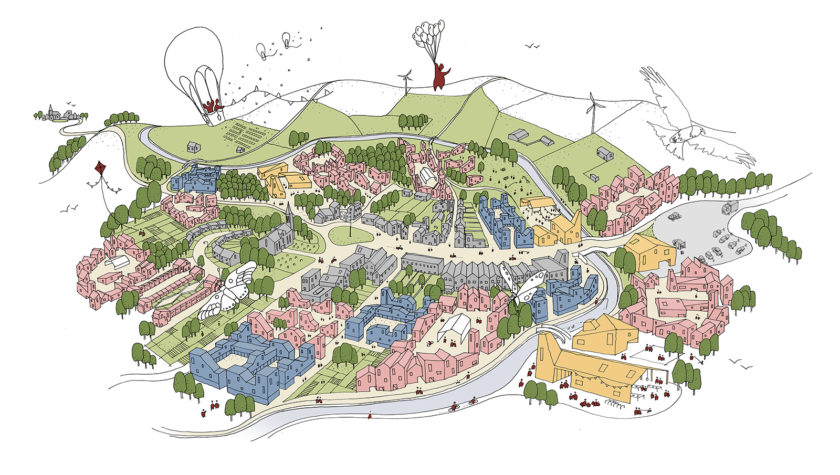A vision for clusters of villages within walking and cycling distance is the winner of a competition to find innovative ways to transform the vital Cambridge-Milton Keynes-Oxford Growth Arc.
The Cambridge-Oxford Connection: Ideas Competition was launched in June and encouraged people from across the infrastructure sector to submit their ideas for delivering homes and improved transport connections across this economically-important part of the country.
Competition jury chairwoman Bridget Rosewell said the winning proposals, from team VeloCity, demonstrated a “commitment to ensuring new settlements would be communities from the get-go.”
Led by urban designers Tibbalds, VeloCity is a multi-disciplinary team comprising architects, urban planners and engineers. Their proposals looked to make the most of the existing character of the area, while creating new communities along the route of the planned East West Rail line.
The judges particularly liked how replicable the plans were across the Growth Arc, based as they were around a new train station – while at the same time planning for people to travel predominantly by bike or by walking, rather than relying on cars.
Under the plans, each village would also include a “big back garden”, a large piece of common land for the whole community to be able to use.
VeloCity will now have their ideas presented as part of a conference and public exhibition planned for early 2018, alongside the three other finalists.
Commissioner and competition jury chairwoman Bridget Rosewell said:
“The jury was drawn to VeloCity’s human scale approach to sensitively and incrementally accommodating new homes, alongside the team’s commitment to ensuring new settlements would be communities from the get-go. Creating effective new settlements can be challenging: the team’s flair and imagination in addressing this shows how good design can translate into liveable communities.”
Chairman of the National Infrastructure Commission Lord Adonis said:
“The competition focused on essential challenges facing the UK, including how to accelerate the supply of affordable homes without sacrificing the quality of the environment, how to engage and enthuse the public in making the choices ahead and to showcase how new infrastructure can creatively enable new communities to flourish over the coming decades.
“The visions and imagery generated by the competition are tools that will inspire a new approach to achieving sensitive, infrastructure-enabled development over the next half century.”
Jennifer Ross, VeloCity team leader, said:
“We’re absolutely thrilled to win. The six of us met taking part in women’s cycling events and became friends through a shared interest in designing places that put the pedestrian and cyclist first. We wanted to work together and the competition was the perfect opportunity. We spent a lot of time discussing density and place-making and how the implementation of new public transport infrastructure can change the way we plan for and think about building successful communities.”
Today’s announcement follows publication of the Commission’s latest report into the Cambridge-Milton Keynes-Oxford Growth Arc, which made recommendations aimed at delivering one million homes by 2050. In his Budget statement, the Chancellor backed this vision for the area with clear milestones planned for the delivery of the East West Rail and Oxford-Cambridge Expressway, and a deal with Oxfordshire to deliver 100,000 homes by 2031.
The Cambridge to Oxford Connection Ideas Competition was run by Malcolm Reading Consultants on behalf of the National Infrastructure Commission. There were 58 entries, with four shortlisted for the final round. Information on the finalists is available on the competition website.
The winning VeloCity team is Jennifer Ross from Tibbalds along with Sarah Featherstone (Featherstone Young), Kay Hughes (Khaa), Petra Marko (Marko and Placemakers), Annalie Riches (Mikhail Riches) and Judith Sykes (Expedition Engineering).




